You can control garden pests naturally by applying food-grade diatomaceous earth in ten effective ways: create barrier rings around individual plants, dust affected leaves directly, establish perimeter defenses around garden beds, target soil-dwelling pest hideouts, combine DE with companion planting strategies, treat compost areas, use spot treatments for heavy infestations, follow seasonal reapplication timing, and employ weather-resistant application techniques. These methods protect your plants while preserving beneficial insects when you discover the specific implementation details for each technique.
Creating Barrier Rings Around Individual Plants
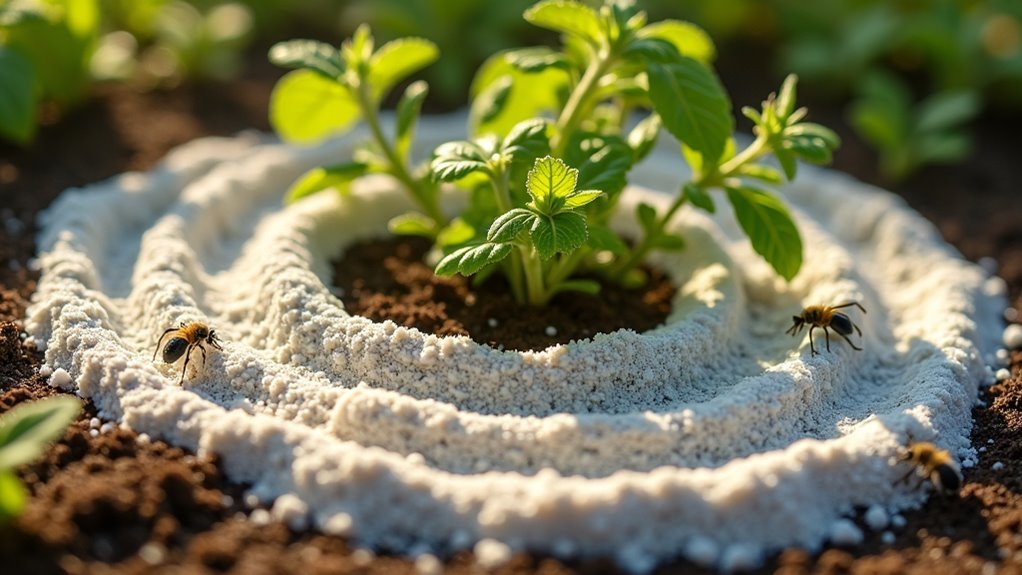
When protecting individual plants from crawling pests, you’ll want to create a continuous barrier ring using food-grade diatomaceous earth around each plant’s base. Sprinkle a 2-4 inch wide band around the entire perimeter to effectively deter slugs and snails.
Apply the barrier rings only during dry conditions, as moisture greatly reduces effectiveness and requires reapplication after rain or high humidity.
Dry conditions are essential for diatomaceous earth effectiveness since moisture compromises the barrier and necessitates frequent reapplication.
Focus your application at ground level rather than dusting leaves to protect beneficial insects like bees and other pollinators.
Monitor your barriers regularly for gaps or disturbances that allow pests to bypass the protection. Reapply fresh diatomaceous earth every few weeks or immediately after heavy rainfall to maintain ideal pest control.
Regular maintenance guarantees your barrier rings remain an effective defense against crawling garden pests.
Dusting Plant Leaves for Direct Pest Contact
Beyond protecting plants at ground level, dusting plant leaves directly with food-grade diatomaceous earth targets pests that climb onto foliage to feed. When you apply D.E. to affected leaves, you’re creating a microscopic obstacle course that damages pest exoskeletons and causes fatal dehydration upon contact.
Focus your application exclusively on leaves, avoiding flowers to protect beneficial pollinators like bees. Apply the powder only during dry conditions when moisture won’t compromise its abrasive properties. Use a light, even coating rather than heavy applications that could block essential sunlight for photosynthesis.
This pest control method requires maintenance after rain or high humidity since wet conditions reduce D.E.’s effectiveness. Reapply as needed to maintain consistent protection against leaf-feeding insects.
Applying Perimeter Defense Around Garden Beds
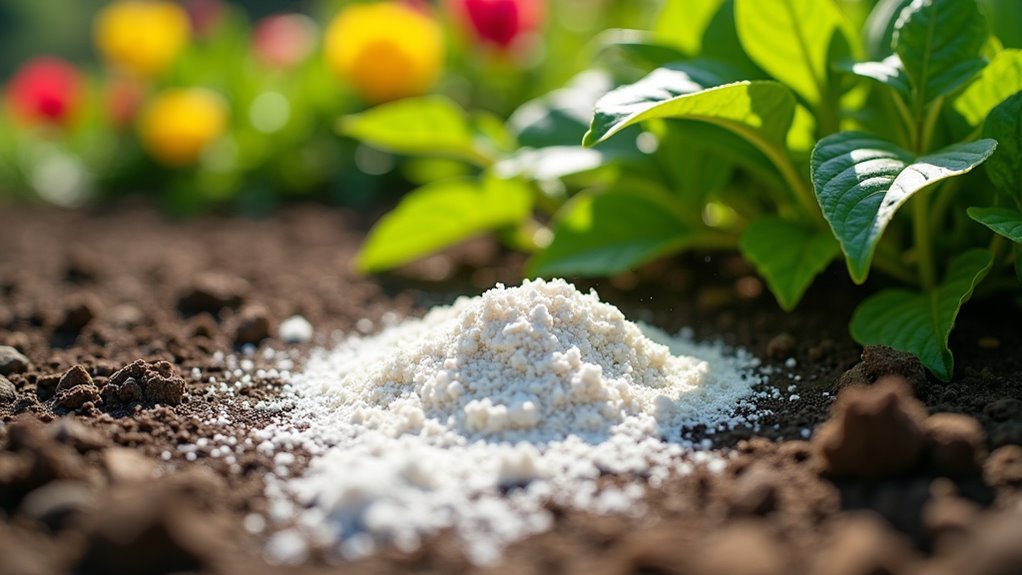
While direct leaf application targets pests already on your plants, establishing a perimeter defense creates a protective barrier that stops crawling insects before they reach your garden beds.
Apply D.E. in an unbroken 1-2 inch wide band around your garden’s outer edges to effectively deter garden pests from entering.
Create an unbroken 1-2 inch band of D.E. around garden perimeters to block crawling pests from reaching your plants.
You’ll achieve best results when you apply Diatomaceous Earth during dry conditions, as moisture reduces its effectiveness.
Check your perimeter regularly for dampness or gaps in coverage, reapplying after rain or high humidity.
Monitor the barrier weekly to maintain continuous protection.
For ideal pest management, combine your perimeter defense strategy with other integrated approaches.
This thorough method enhances your garden’s overall health while greatly reducing pest populations before they become problematic.
Targeting Soil-Dwelling Pest Hideouts
Many of your garden’s most persistent pests establish their strongholds beneath the soil surface, where they feed on roots, pupate into adults, and lay eggs for future generations.
Diatomaceous Earth provides an effective solution for disrupting these hidden pest havens. Sprinkle a fine layer around plant bases to create deadly barriers that force soil-dwelling pests to cross treated zones, causing fatal dehydration.
You’ll achieve better pest control by mixing D.E. directly into topsoil layers, targeting grubs, root maggots, and beetles where they live and breed.
Apply during dry conditions for maximum effectiveness. Since moisture reduces D.E.’s potency, you must reapply after rainfall or irrigation to maintain protective barriers and guarantee continuous elimination of underground pest populations.
Combining DE With Companion Planting Strategies
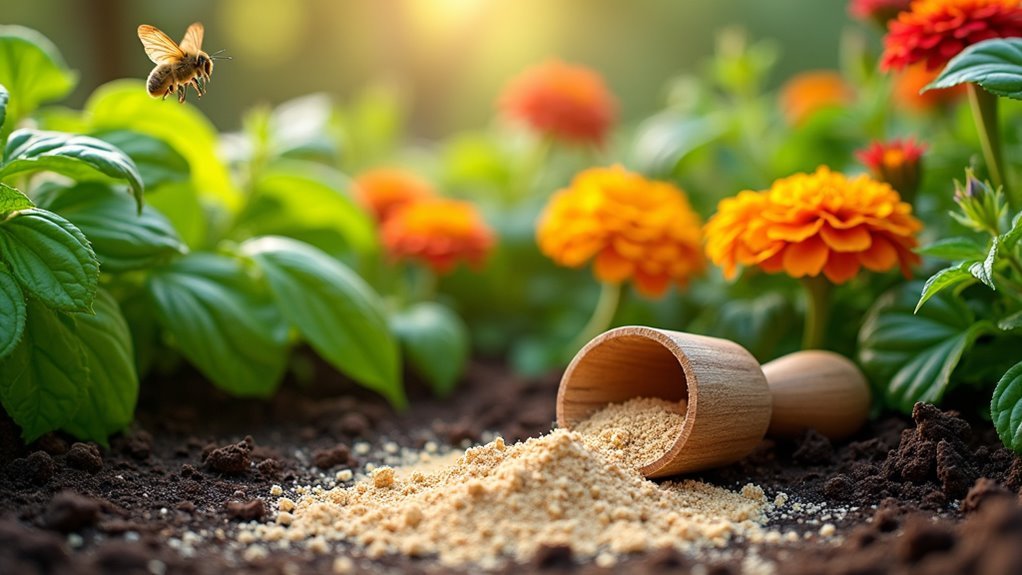
Although diatomaceous earth works effectively on its own, you’ll amplify your pest control success by pairing it with strategic companion planting.
Marigolds and basil naturally repel aphids and nematodes, while DE creates an additional barrier against soft-bodied insects. This combination builds a diverse ecosystem that deters harmful pests without compromising beneficial insects.
Combining marigolds and basil with diatomaceous earth creates a powerful, eco-friendly pest control system that protects beneficial insects while deterring harmful ones.
When implementing this strategy, apply thin layers of diatomaceous earth around your companion plants to minimize disruption to pollinators.
Strong-scented herbs and flowers mask vulnerable crop scents, reducing pest attraction and allowing DE to target those insects that still approach your garden.
Monitor both your DE application and companion plant health regularly.
This guarantees you maintain beneficial relationships while effectively controlling pest populations through this integrated approach.
Using DE in Raised Bed Applications
Raised beds offer unique advantages for diatomaceous earth applications since their contained structure allows you to control DE distribution more precisely than traditional garden plots.
You’ll create an effective protective barrier against crawling pests like slugs and snails by applying a thin, even layer around plant bases and bed edges.
Key Application Strategies:
- Surface Treatment – Sprinkle DE on soil surface and maintain dryness for maximum effectiveness against soft-bodied insects.
- Soil Integration – Mix DE into top soil layers to improve drainage while providing plants with strengthening silica.
- Selective Placement – Focus on ground-level bands rather than excessive leaf dusting to protect beneficial insects like pollinators.
Monitor moisture levels regularly in your raised bed applications, as wet DE loses potency and requires reapplication after rain or watering sessions.
Treating Compost Areas to Prevent Pest Breeding
While compost piles provide essential nutrients for your garden, they can unfortunately become breeding grounds for destructive pests that’ll spread throughout your growing areas.
Diatomaceous Earth (DE) offers an effective solution for controlling soft-bodied insects like slugs and snails in your compost. Apply a thin layer around your compost area’s edges and mix it into the top layers to create protective barriers. DE works by dehydrating pests on contact, providing natural pest control without chemicals.
Monitor moisture levels carefully since wet DE loses effectiveness. Reapply after rainfall or high humidity periods.
Beyond pest control, incorporating DE improves compost quality by enhancing drainage and aeration, making your compost healthier while keeping destructive insects away.
Spot Treatment for Heavy Infestation Areas
You’ll need to pinpoint the most heavily infested zones in your garden where pests have concentrated their activity.
Once you’ve located these problem areas, you can apply a more concentrated layer of diatomaceous earth using specific techniques that maximize contact with the target pests.
The timing of your reapplication becomes essential since heavy infestations require more frequent monitoring and retreatment to break the pest cycle effectively.
Identifying Problem Areas
Where exactly should you focus your diatomaceous earth applications for maximum impact? Identifying problem areas requires careful observation of your garden to spot signs of pest activity.
Look for chewed leaves, insect droppings, and visible bugs clustered on plants.
When you’ve located these trouble spots, you can apply D.E. strategically rather than broadcasting it everywhere. This targeted approach saves product while delivering maximum pest control where it’s needed most.
Key indicators to watch for:
- Leaf damage patterns – Holes, notches, or yellowing that indicate feeding activity
- Insect clustering – Groups of aphids, beetles, or other pests concentrated on specific plants
- Fresh droppings – Small pellets or residue showing recent pest presence
Once you apply D.E. to these areas, monitor treated areas regularly and reapply after rain or heavy moisture.
Application Concentration Methods
Heavy infestations demand a more concentrated approach than light dusting across your garden. For maximum pest control effectiveness, apply a thicker layer of food-grade DE directly onto affected plants and surrounding soil. This application concentration method guarantees ideal contact with pests in problem areas.
Apply DE only during dry conditions, as moisture destroys its dehydrating properties. Focus your efforts around plant bases and on leaves where you’ve spotted pest activity, but avoid heavy dusting on flowers to protect beneficial pollinators.
You’ll need to reapply DE every few days or immediately after rainfall, since wet conditions cause clumping and reduce effectiveness.
Monitor treated areas closely to gauge pest activity levels and adjust your application frequency accordingly for best results.
Reapplication Timing Schedule
Since heavy pest infestations require aggressive treatment, you’ll need to reapply diatomaceous earth every 24 hours in severely affected areas to maintain its lethal effectiveness.
The powder loses potency when exposed to moisture, making frequent applications essential for continuous pest control.
Monitor environmental conditions closely, as rain and high humidity render diatomaceous earth ineffective. Apply a fine layer directly onto affected plants and around the perimeter to create protective barriers against pests.
Critical Reapplication Triggers:
- Environmental Disruption – Reapply immediately after rain, watering, or strong winds that displace the powder
- Weekly Maintenance – Continue weekly applications until infestation resolves, monitoring pest activity levels
- Moisture Exposure – Fresh application necessary after any high humidity conditions that compromise effectiveness
Seasonal Reapplication Timing Methods
Timing your diatomaceous earth reapplications correctly throughout the growing season guarantees maximum pest control effectiveness.
You’ll need to reapply strategically as seasonal conditions change and different pests emerge.
Start early in spring by establishing your protective barrier before pests become active. Target emerging slugs and snails that thrive in warmer weather conditions.
During summer’s peak pest season, monitor your plants weekly and maintain consistent coverage against soft-bodied insects.
Weather events require immediate attention. After rainfall or high humidity, reapply diatomaceous earth since moisture clumps the powder and reduces its abrasive action.
Strong winds also displace applications, so check and supplement coverage as needed.
Continue seasonal applications through fall until the first significant frost eliminates remaining active garden pests.
Weather-Resistant Application Techniques
While seasonal timing sets the foundation for effective pest control, you’ll need specific techniques to guarantee your diatomaceous earth applications withstand challenging weather conditions.
Weather notably impacts DE effectiveness. Moisture destroys the powder’s abrasive properties, making reapplication essential after rainfall or high humidity. You must monitor weather forecasts and apply during dry weather periods for maximum pest control results.
Three Essential Weather-Resistant Techniques:
- Create thicker barriers around plants to protect against wind displacement and ensure adequate coverage remains intact during strong gusts.
- Use lightweight, portable applicators for precise dusting that allows targeted application even when conditions aren’t ideal.
- Time applications strategically by applying just before forecasted dry spells to enhance longevity and maintain the barrier’s pest-deterring capabilities longer.
Frequently Asked Questions
How to Use Diatomaceous Earth for Pest Control in Garden?
You’ll apply food-grade diatomaceous earth around plant bases and dust leaves lightly. Reapply after rain since moisture reduces effectiveness. Use during dry weather and avoid flowers to protect beneficial insects like bees.
What Are the Downsides of Diatomaceous Earth?
You’ll face reapplication needs after rain, potential harm to beneficial insects, reduced plant photosynthesis from excessive use, respiratory irritation risks during application, and constant monitoring requirements for effectiveness.
What Not to Mix With Diatomaceous Earth?
You shouldn’t mix diatomaceous earth with water, chemical pesticides, high-moisture fertilizers, oils, or wet organic matter. These combinations reduce its abrasive properties and pest control effectiveness by clumping the powder or coating particles.
Why Do Exterminators Not Use Diatomaceous Earth?
You’ll find exterminators avoid diatomaceous earth because it works too slowly, requires constant reapplication when wet, needs perfect coverage, and can’t match chemical treatments’ immediate results in commercial settings.
In Summary
You’ve now got a complete arsenal of diatomaceous earth techniques to protect your garden naturally. Remember, consistency is key—reapply after rain and monitor problem areas regularly. Don’t forget to wear protective gear when applying DE, and always use food-grade quality. Start with the methods that target your specific pest issues, then expand to thorough coverage. With these strategies, you’ll maintain a healthier, pest-free garden all season long.


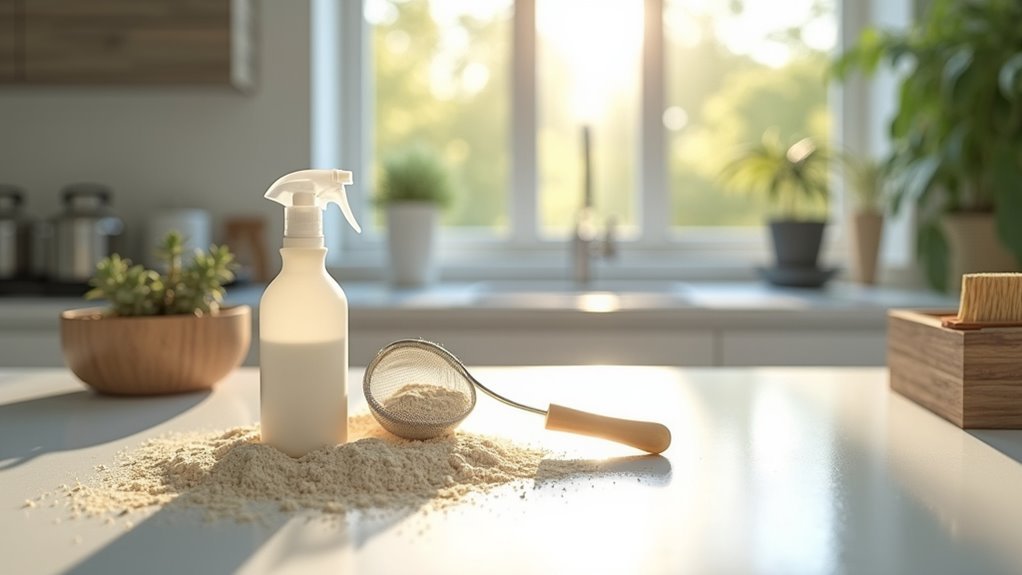
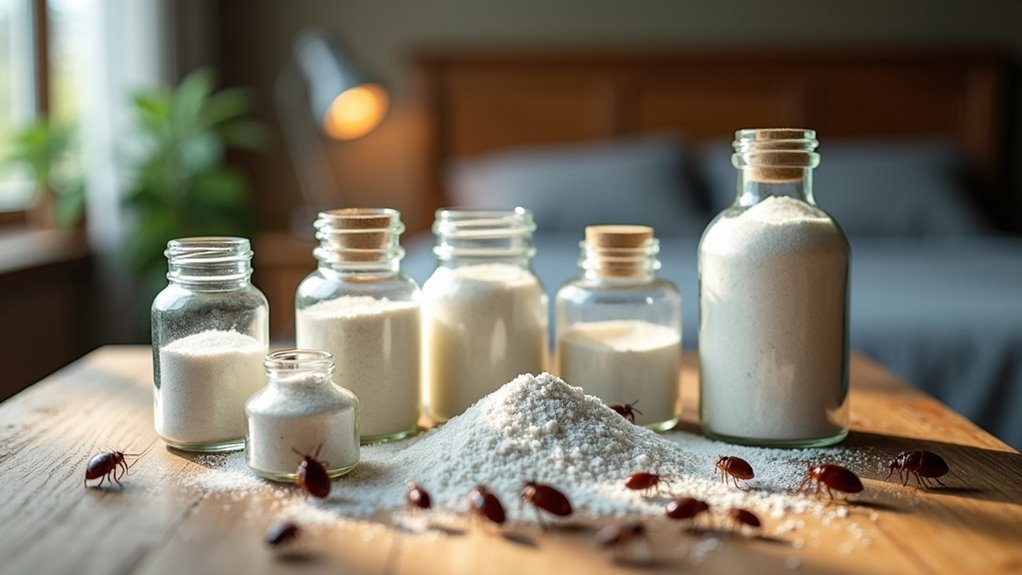
Leave a Reply